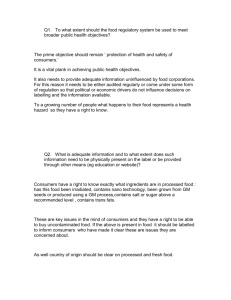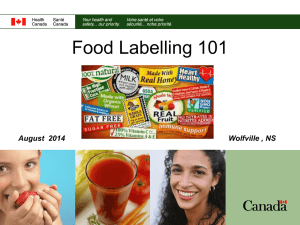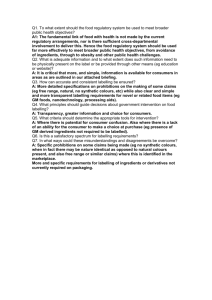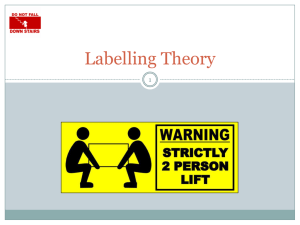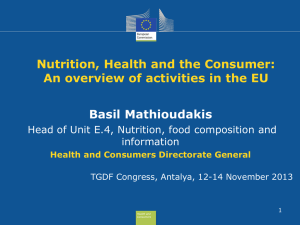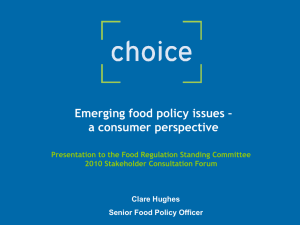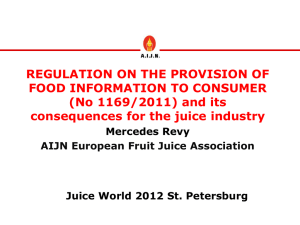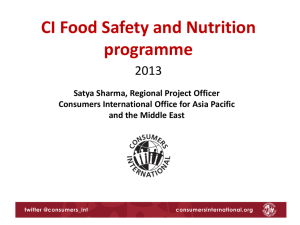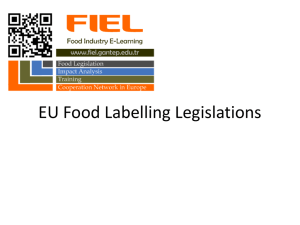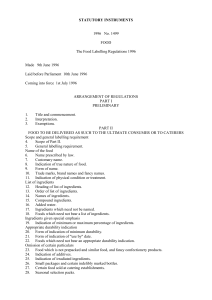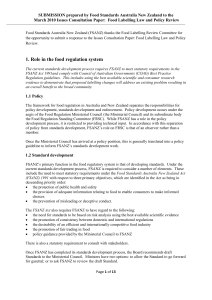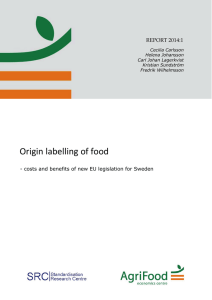Labelling - food
advertisement
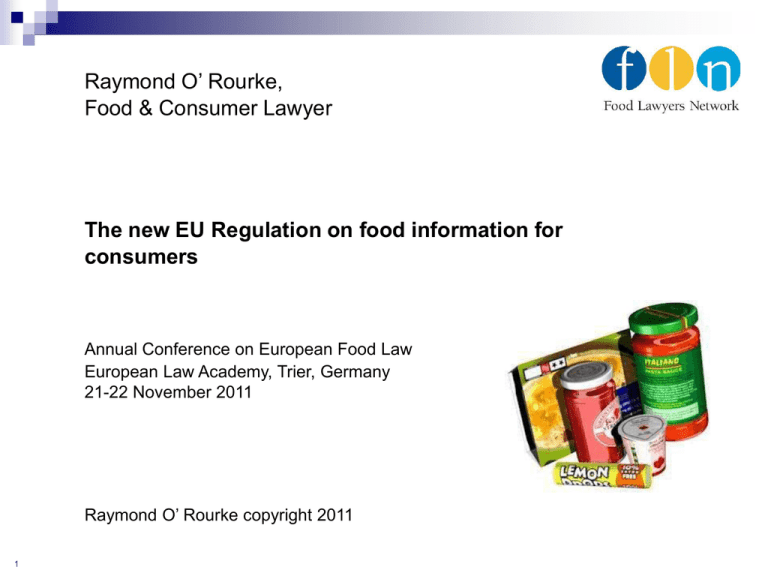
Raymond O’ Rourke, Food & Consumer Lawyer The new EU Regulation on food information for consumers Annual Conference on European Food Law European Law Academy, Trier, Germany 21-22 November 2011 Raymond O’ Rourke copyright 2011 1 DG SANCO public consultation (Feb 2006) Labelling: Competitiveness, Consumer Information & Better Regulation for the EU Strategic Goal for food labelling Provide consumer with information to enable them make safe, healthy & sustainable choices Create a pro-competitive market environment in which dynamic, efficient innovative operators can make full use of the power of labelling to sell their products Be consistent, coherent and transparent Create common framework & rules in order to eliminate barriers to free circulation of goods DG SANCO public consultation (Feb 2006) Labelling: Competitiveness, Consumer Information & Better Regulation for the EU Strategic Goals reflect the following issues: ‘labelling must not be misleading’ principle (Dir. 2000/13); Consumer Rights (right to consumer info); internal market (Cassis de Dijon) competition. Commission received 175 responses - Com (2008)40 Industry wanted to see limited new food labelling rules whilst consumer, health & animal welfare NGOs wanted more food labelling requirements What must be on a label? name of food list of ingredients (in descending order) QUID information (if needed) net quantity of food present (unless under 5g) date mark (use by and best before) any special conditions or conditions of use name & address of manufacturer, packager or seller place of origin (if leaving out would mislead) any necessary instructions for use Alcoholic strength – if more than 1.2% vol Nutrition declaration – voluntary – but specific format if you want to make declaration Additional requirements Beef Labelling – traceability GMOs Vertical Directives – chocolate, marmalade, jams Food Supplements PARNUTS Fortified foods PDOs/PGIs Organic labelling Nutrition & health claims Commission Proposal COM (2008) 40 Initial proposal – 30/1/2008 1st EP reading – 16/6/2010 Council adopts Common Position 21/2/2011 2nd EP reading – 6/7/2011 Council adopts Common Position 27/7/2011 Final adoption by EP/Council – September 2011 Transitional periods for the implementation of the Regulation – 5 years Commission Proposal COM (2008) 40 Issues not dealt with: Language Colim NV v. Biggs Continent Noord NV [1999]; Herman Josef Goerres [1998] Yannick Geffroy v. Casino France [2000] Court decided Member States cannot introduce ‘’1-language-only’ laws like France, consumers not confused if ‘Coca-Cola’, but will be if ‘Corn Flakes’ sold in Germany with Italian labelling !!!! Lidl ECJ case – liability issues Misleading Terms: ‘pure’ ‘natural’ ‘traditional’ ‘authentic’ ‘home-made’ Commission Proposal COM (2008) 40 Food information def: means information concerning a food and made available to the final consumer by means of a label, other accompanying material, or any other means including modern technology tools or verbal communication; Principles of food labelling law high level of protection of consumers’ health & interests assist in the free movement of foodstuffs - Internal Market transitional periods be offered to introduce such obligations open dialogue & consultation with stakeholders during law changes food information should not be misleading & be provided in a clear, accurate & easy to understand format for the consumer so they can make ‘informed’ choices obligations placed on food business operators throughout the food chain [like Reg 178/2002] to ensure information is accurate & in line with EU Law Nutrition Labelling New rules on nutrition declaration applies to Parnuts legislation, but not legislation on food supplements & natural mineral waters. Declaration shall include: energy value amounts of fat, saturates, carbohydrate, sugars, protein and salt [NB – order has changed with fats first etc.] the following items can be added to the declaration as a supplement - monounsaturates; polyunsaturates; polyols; starch; fibre; vitamins or minerals (in Annex XIII) trans-fats – Commission to complete a report within 3 years on the scientific evidence in Member States, diets, dietary guidelines etc – as a means of assessing the need for a mandatory declaration for trans-fats Nutrition Labelling Declaration in addition to per 100g/100ml shall also include: a per portion basis or per consumption unit Commission will prepare a report [taking into account consumption behaviour & dietary recommendations] & then introduce rules on how such an obligation can be implemented in all Member States All nutrition particulars will be presented in the same field of vision, in a set font size as per Annex XV [box format] Additional nutritional information can be provided once it is based on sound & scientifically valid consumer research; is objective, non-discriminatory & does not create obstacles to the free movement of goods Nutrition Labelling INDUSTRY V. CONSUMER NGOs Member States permitted to recommend to food business operators one or more additional formats to provide nutritional information & shall provide the Commission with such additional approved formats. M.S. can also demand food business operators notify them of any new formats they intend to utilise Origin Labelling Country of origin will become mandatory for ‘meat’ as defined in the Combined Nomenclature (CN) – so that means in addition to the existing case of beef – lamb, pork, goat, chicken - implementing rules [within 2 years] Place of origin or provenance of the food or the primary ingredient will be indicated [place of birth, place of rearing and place of slaughtering] – like Beef Labelling regulations The Commission will bring forward implementing rules on meat used as an ingredient [within 2 yrs] following preparation of a Report on meat origin labelling which will include an analysis of the costs and benefits of the introduction of such measures, including the legal impact on the internal market and the impact on international trade. The Commission will prepare a Report [within 3 yrs] on the feasibility of origin labelling for other meats (rabbit), milk, milk used an ingredient; unprocessed foods, single ingredient products, ingredients that represent more than 50% of the product Alcohol Labelling A list of ingredients & nutrition declaration shall not be mandatory for alcoholic beverages containing more than 1.2% by volume of alcohol – “status quo” Commission to prepare a Report on whether this situation should be maintained in future especially taking into account other EU public health policies The Report should consider the need to propose a definition of ‘alcopops’ The Report should be accompanied with legislative proposals if deemed necessary Allergen Labelling Allergens as listed in Annex II [includes cereals, nuts, peanuts, soybeans, milk, crustaceans, fish, eggs, celery, sesame seeds, mustard, sulphur dioxide, lupin, molluscs] shall be indicated on the food label for emphasis by means of a typeset that clearly distinguishes from other ingredients e.g. by means of the font, style or background colour In the absence of a list of ingredients the allergen should be indicated as: ‘contains ….. Indication of the allergen (nuts) where it is included in the name of the food product e.g. fruit & nut chocolate bar Allergen information will now be mandatory for ‘non pre-packed food’ - farmers markets, restaurants etc. Member States can adopt national rules as to the means by which this information is provided to the consumer – so a Member State could decide that it can be given orally or by other means. Font Size Minimum font size of 1.2 mm x. height Where the largest surface area is 80cm x. height then the font size will be 0.9mm Annex IV provides further detail – rules on legibility to be established by Commission Distance Selling Mandatory info ( except date) must be available before purchase concluded and all info must be available upon delivery (exemption - vending machines or automated commercial premises) Non prepacked foods – subject to national rules Vegetable Oils Must state its origin i.e. rapeseed, corn, sunflower or palm oil If a mixture of refined oils of vegetable origin – must state the origin of each and can follow that with the phrase ‘in varying proportions’ Same labelling rules for vegetable fats Voluntary Food Information Animal Welfare European Parliament sought method of slaughtering labelling – Commission asked to prepare a study on the opportunity to provide consumers with the relevant information on the stunning of animals should be considered in the context of future Union strategy for the protection and welfare of animals. Vegetarians/Vegans Commission asked to bring forward possible rules on information relating to the suitability of food for vegetarians/vegans Reference intakes for specific population groups Commission asked to bring forward possible rules on reference intakes of vitamins, minerals & energy for specific population groups Meat products – added ingredients Requires added ingredients in meat products – such as water & added ingredients (proteins) – these must now be labelled prominently on products This provides consumers with more information to make informed choices Sausage Casings Must be labelled as ‘natural casing’ or ‘artificial casing’ Milk Milk can only be labelled as ‘fresh’ when its use-by date is less than 7 days after its filling date Member States may derogate from demanding mandatory labelling items to be placed on milk and milk products presented in glass bottles intended for reuse Frozen foods Labelling of foods frozen and sold defrosted was subject to discussion in European Parliament - additional information will only need to be provided where consumers would be mislead or the product would not be suitable for re-freezing as a result of being defrosted Nanotechnology Def: ‘engineered nanomaterial’ Must be clearly indicated in the list of ingredients using the word ‘nano’ Imitation Foods Where a foodstuff contains an imitation food or a substitute for an ingredient normally used in a product, the packaging must prominently bear the marking ‘imitation’ or ‘produced with (designation of the substitute ingredient) instead of (designation of the ingredient replaced)’ CONCLUSIONS Implementation – various reports, implementing rules to be brought forward by the Commission – so offering the opportunity for changes or decisions not to introduced rules as agreed in the final text of the Regulation Food Industry marketing – own-label schemes esp. Nutrition – the Regulation offers opportunities for food companies Private food quality schemes – Fairtrade, Red Tractor, regional foods ECJ cases – language issue – need for clarification – other issues may emerge from other cases Nutrition & Health Claims – amendment of PARNUTS – highlight additional future labelling issues

